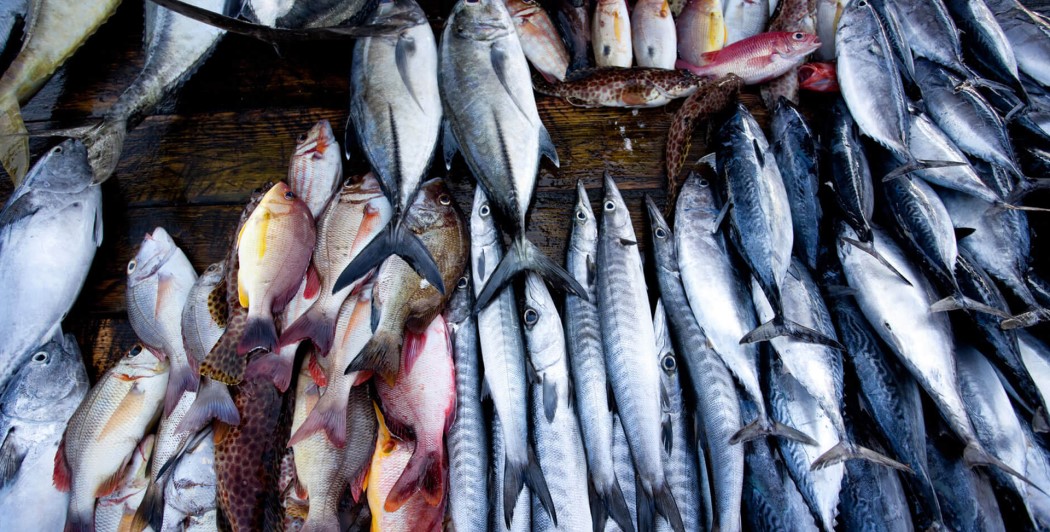
| Yellowfin Tuna | Bluefin Tuna | Barramundi | Fish Maw |
A tear-shaped island hanging from the southernmost tip of India, Sri Lanka is blessed with a coastline of 1340 km and an exclusive economic zone that span across 200-nautical-mile (370km) of the ocean to the maximum depth of 6,000m.
The coastline of the country is cluttered with fishing communities that merge traditional know-how with state-of-the-art modern technology to make the most out of their trade. From traditional techniques like still fishing or ‘Riti Panna’ as it is known among the locals, the Sri Lankan fisheries industry certainly has come a long way to where it is today, emerging as a major fisheries supplier with a fleet of more than 4500 fishing boats. At present, Sri Lanka exports a variety of fish and chief among them are yellowfin tuna, bluefin tuna, barracuda and fish maw.
Hailed as one of the most widely consumed fish varieties, Yellowfin Tuna gets its name from the somewhat saffron-hued fins it sports on the sides. They generally inhabit warm pelagic waters, which means that the tropical waters of Sri Lanka located near the equator provide favourable habitats for them. As a result, large schools of Yellowfin Tuna thrive in Sri Lankan waters, providing ample opportunities for local fishermen to harvest them all year long.
Yellowfin Tuna caught in Sri Lankan waters has a distinctly pronounced flavour that makes it a much sought-after variety in global markets. Consumed either cooked or raw its meat is a delicacy that many seek to indulge in.
However, the widely sought-after status of this Sri Lankan fish product is not solely due to its flavour. The manifold health benefits it brings to consumers also become a factor here. Yellowfin Tuna teems with nutrients crucial for the proper functioning of the human body. For example, The mushy and bright red flesh of the Yellowfin Tuna is compacted with minerals and vitamins such as selenium, prosperous, potassium, vitamin B, B16 and Vitamin D. Above all, one serving of yellowfin tuna contains 93 calories, meaning that it is a source of energy for the human body.
The largest among all the tuna species, the Bluefin Tuna is a common target of commercial fisheries. The demand for Bluefin Tuna is always rising, owing to the escalated popularity of sushi, sashimi and Japanese cuisine in general.
Sri Lanka is known for exporting high-quality Bluefin Tuna manufactured and exported while preserving the natural freshness, a reason why Sri Lankan Bluefin Tuna is highly used in Sushi.
Quite analogous to Yellowfin Tuna, Bluefin Tuna is also a powerhouse full of nutrients. It contains a significant amount of Omega 3 fatty acids aka good fats that bring multiple health benefits. For instance, 3 ounces of bluefin tuna contains the daily requirement of 1- 4 grams of good fats that reduce the risk of heart disease and cancer. Bluefin Tuna is also enriched with vitamin A, B, E and D alongside minerals like iodine, zinc, magnesium and potassium, making it an essential part of healthy diets. Packed with protein and energy, Bluefin Tuna further enables consumers to lead active and healthy lives.
Known by many names like Asian Seabass, Giant Perche and Palmer, Barramundi is a species of fish that inhabits freshwater, saltwater and estuaries. Distinguished by its scales, Barramundi makes a delicious treat for anyone looking for a relatively ‘safer flavour’. Considered to be the best starting point for those who are new to the fish flavour palette, the white-fleshed Barramundi depicts subtle flavour tones, playing it safe with the taste buds.
Though the flavour of Barramundi is subtle, the gamut of health benefits it brings is rather impressive. It is known to have nutritional properties that reduce the risk of inflammation, heart disease and anxiety. A six-ounce barramundi fillet contains 50 milligrams of calcium and 34 grams of protein. The calorie count of the fillet is at 185 calories and provides 4% of the daily Vitamin A requirement of an adult. Due to all these health benefits, Sri Lankan Barramundi is in high demand, particularly in the UK, the USA, Australia and the Middle East.
Commonly known as the ‘dried fish swim bladder’, the fish maw is the dried internal gas-filled organ that aids fish to maintain their buoyancy in water. Even though the making of sun-dried fish maw is a somewhat tedious task, Sri Lankan fishermen are well-known for their ability to produce the best quality fish maw.
Occupying a prominent position among traditional Chinese delicacies, fish maw is a spongy and taste-less fish product that is believed to nourish ‘yin’. Often added as a complementary ingredient, fish maw is widely celebrated for its nutritional value. It contains 84.4% protein and 0.2% fat. The low-fat count makes it heart-friendly, reducing the risk of high blood pressure. Rich in collegian, fish maw is highly effective in improving skin health and reducing the appearance of ageing. Due to the high level of collagen, an easy-to-digest source of protein that improves the elasticity of the skin and reduces wrinkles, Fish Maw is considered a beauty secret in Asian cultures.
No matter what the product is, Sri Lanka ensures that they reach international markets in pristine quality with their natural goodness intact. Produced and manufactured according to global and local quality standards, the freshness of Sri Lankan fish products is vouched for by regular customers. This is the driving force behind the rising demand for Sri Lankan fish products in the global fisheries market.
Sri Lanka’s seafood product sector has emerged as a quality exporter of a wide variety of fish, with the most popular of them being tuna. Sri Lanka’s rich and relished seafood of different varieties are available through an extensive network of exporters.